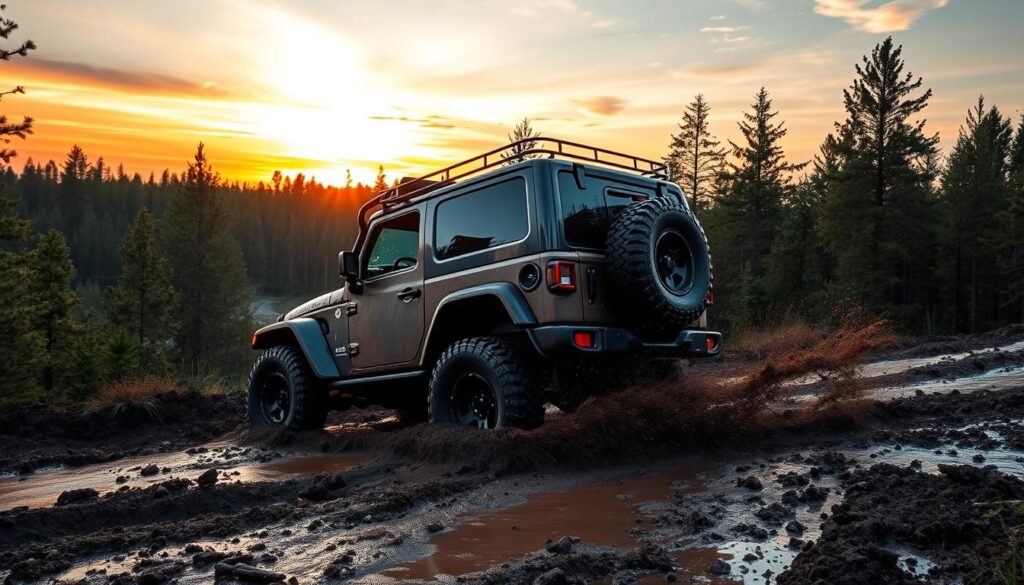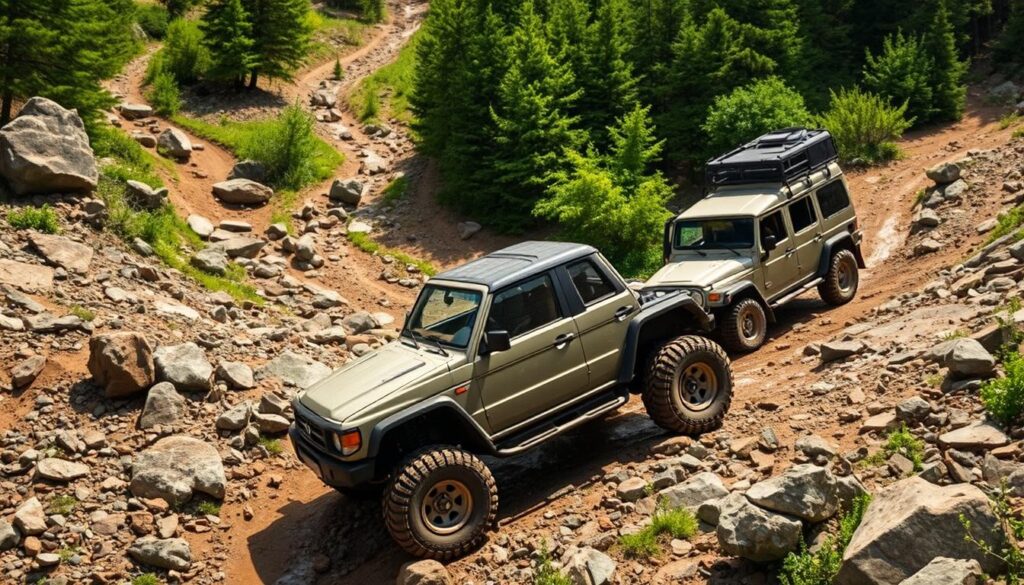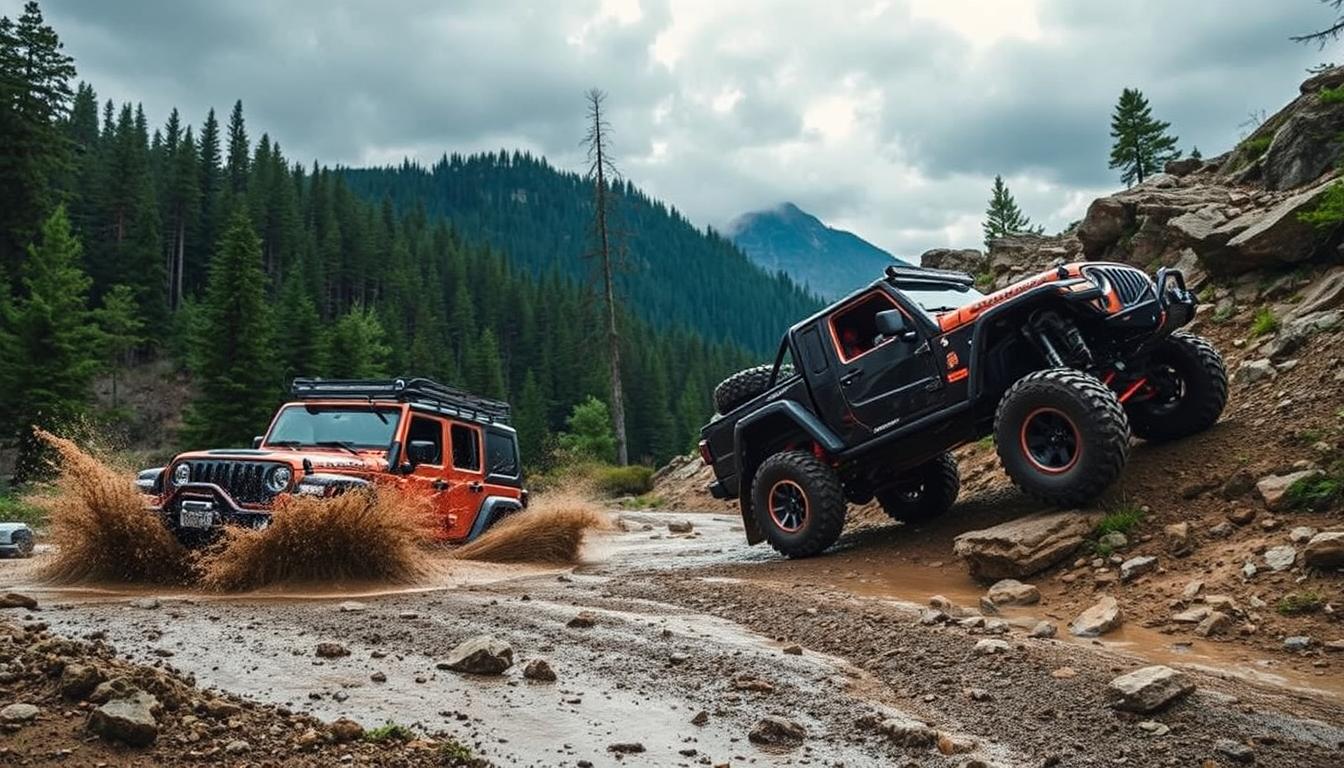I love off-roading and have always been curious about different vehicle systems. The debate between 4×4 and all-wheel drive (AWD) really caught my attention. I’ve seen how each system handles tough terrain.
In this article, we’ll dive into the world of off-road vehicles. We’ll help you choose the right system for your adventures. Whether you’re tackling rough trails or exploring new landscapes, we’ve got you covered.
In This Guide
Understanding the Fundamentals of 4×4 and AWD Systems
Choosing between a four-wheel drive (4×4) system and an all-wheel drive (AWD) system is key for off-road driving. Knowing the basics of these systems helps you decide which one is best for you. Each system has its own way of distributing power and handling different terrains.
Basic Components of 4×4 Systems
A 4×4 system has a transfer case that splits the engine’s power. This lets all four wheels get power, improving traction and control off-road. It also includes locking differentials to ensure equal power to each wheel, even on uneven surfaces.
Core Elements of AWD Systems
AWD systems use a center differential to adjust power to the front and rear axles. This adjustment helps keep the vehicle stable on various surfaces. It’s great for both dry roads and slippery paths.
Power Distribution Mechanisms
The main difference between 4×4 and AWD systems is how they distribute power. 4×4 systems have a mechanical power transfer and can lock differentials for better off-road performance. AWD systems use electronic sensors and controls for a more adaptive traction experience.
Knowing the basics of 4×4 and AWD systems is important. It helps you choose the right one for your off-road adventures.
The History and Evolution of Off-road Drive Systems
The story of off-road vehicles, four-wheel drive, and all-wheel drive is quite interesting. It shows how car technology has grown over time. These systems started in the military, where they helped vehicles move better in tough places.
The Willys Jeep from World War II was a big step forward. It was fast and tough, making it great for the military. This led to more four-wheel drive cars for both the military and regular people.
Later, all-wheel drive (AWD) came along. It was better and more flexible than four-wheel drive. New tech made it work smoothly, helping cars grip the ground better in many situations.
Now, off-road vehicles are amazing. They have new tech for driving on rough terrain. These cars can go fast in the desert or slow on rocks. They show what’s possible in off-road adventures.

“The evolution of off-road drive systems has been a game-changer, empowering us to venture further into the wild and discover the true potential of our vehicles.”
| Milestone | Year | Significance |
|---|---|---|
| Willys Jeep introduced | 1941 | Pioneering 4×4 vehicle for military use |
| First consumer 4×4 vehicles | 1950s | Brought off-road capability to the mainstream |
| Electronic AWD systems developed | 1980s | Improved traction and performance in diverse terrain |
| Intelligent terrain response systems | 2000s | Enabled greater adaptability to off-road conditions |
4×4 vs AWD Off-roading: Key Differences and Capabilities
Choosing between a 4×4 and an AWD system affects your off-road driving. It’s important to know the differences to pick the right one for your needs.
Power Transfer Methods
4×4 systems send power to all four wheels through a transfer case. They also have low-range gearing for more torque. AWD systems, however, adjust power based on wheel traction without driver input.
Terrain Response Features
Modern 4×4 vehicles have advanced features like traction control systems and differential locks. These help improve off-road performance by adjusting to the terrain.
System Activation Mechanisms
4×4 systems need manual activation. Drivers can switch between two-wheel and four-wheel drive. AWD systems are automatic, adjusting power without driver action.
Choosing between 4×4 and AWD depends on your off-road needs and terrain. Knowing how each system works helps make the right choice for your terrain capability needs.
| Feature | 4×4 System | AWD System |
|---|---|---|
| Power Transfer | Transfer case sends power to all four wheels | Continuously monitors and adjusts power distribution |
| Terrain Response | Offers advanced traction control systems and differential locks | Relies on automatic adjustments to maintain traction |
| Activation Mechanism | Requires manual engagement by the driver | Fully automatic, seamless power distribution |

“The choice between a 4×4 and an AWD system ultimately depends on your specific off-road needs and the terrain you’ll be traversing.”
Traction Control and Differential Locks Explained
When you’re off-roading, the right traction control and differential locks are key. These technologies boost your 4×4 or AWD vehicle’s abilities. They help you handle tough terrain with confidence.
Traction control systems keep your wheels from spinning too much. This prevents loss of control and stability. They adjust the engine or apply brakes to keep traction, even on slippery surfaces. This is super helpful on off-road trails where things can get unpredictable.
Differential locks lock the two wheels on an axle together. This ensures they turn at the same speed. If one wheel loses traction, the differential locks power to the better-gripping wheel. This keeps your vehicle moving forward, even in tough off-road conditions.
| Feature | Traction Control Systems | Differential Locks |
|---|---|---|
| Function | Prevents wheel spin and maintains traction | Locks the two wheels on an axle together, ensuring equal power distribution |
| Benefit | Improved stability and control on slippery surfaces | Enhances traction and prevents getting stuck in challenging off-road conditions |
| Activation | Automatic, based on wheel speed and sensors | Manual or automatic engagement, often with a dedicated control or button |
Knowing how traction control and differential locks work helps you choose the right vehicle for off-roading. These features give you the grip and control you need. They let you explore the outdoors with confidence.

Ground Clearance and Vehicle Architecture Comparison
Ground clearance and vehicle architecture are key for off-road performance. The distance from the lowest part of your vehicle to the ground is vital. It helps you avoid scraping or getting stuck on rough terrain.
The approach and departure angles, along with the breakover angle, are also important. They help your vehicle tackle steep inclines and uneven surfaces.
Approach and Departure Angles
The approach angle is how steeply you can go up without hitting the ground. The departure angle is how steeply you can go down without scraping the ground. These angles are crucial for navigating steep hills and large rocks.
Breakover Angles and Body Design
The breakover angle is how steeply you can go over a high point without touching the ground. It’s key for off-road vehicles to avoid getting stuck or damaged. The vehicle’s body design, including the wheelbase and ground clearance, affects this angle.
Suspension Systems and Articulation
The suspension system is vital for off-road performance. Vehicles with advanced suspension systems, like independent suspension or coil-over shocks, offer better articulation. This means they can stay in contact with the ground on uneven surfaces, improving traction and stability.
| Feature | 4×4 | AWD |
|---|---|---|
| Ground Clearance | Higher | Lower |
| Approach/Departure Angles | Steeper | Less Steep |
| Breakover Angle | Greater | Smaller |
| Suspension Articulation | More Flexible | Less Flexible |
This comparison shows 4×4 vehicles have an edge over AWD vehicles off-road. Knowing about ground clearance, angles, and suspension is key to picking the right off-road vehicle.
Performance Analysis in Different Terrain Types
Off-road adventures depend a lot on your vehicle’s terrain capability. Both 4×4 and AWD systems have their own strengths in different terrains. Knowing how they perform is key to picking the right one for your off-road needs.
On soft surfaces like sand or snow, AWD systems usually do well. They offer good traction and agility without needing to switch to four-wheel drive. Their advanced systems help keep you moving forward, even in tough conditions.
But, rugged terrain with steep inclines and loose rocks is better for 4×4 systems. They can lock differentials and use low-range gearing. This gives 4×4 vehicles an advantage on the toughest trails.
| Terrain Type | 4×4 Performance | AWD Performance |
|---|---|---|
| Mud | Excellent | Good |
| Sand | Good | Excellent |
| Rocks | Excellent | Good |
| Snow | Good | Excellent |
The choice between 4×4 and AWD depends on the terrain and your needs. Knowing the strengths and weaknesses of each system helps you make a better choice. This choice will improve your off-road adventures and let you conquer any terrain with confidence.

“The true test of a vehicle’s off-road prowess lies in its ability to adapt to the ever-changing landscape. Whether you prefer the raw power of a 4×4 or the versatility of an AWD system, the right choice will unlock a world of thrilling exploration.”
Maintenance Requirements and Reliability Factors
When you own an off-road vehicle, it’s important to keep it in good shape. This means regular maintenance for both four-wheel drive (4×4) and all-wheel drive (AWD) systems. Knowing when to service your vehicle, the costs involved, and common problems can help you stay on track.
Service Intervals and Costs
Keeping your off-road vehicle running well requires regular care. Here are some service intervals to remember:
- Engine oil and filter changes every 5,000 to 10,000 miles
- Differential fluid changes every 30,000 to 50,000 miles
- Transfer case fluid changes every 30,000 to 50,000 miles
- Inspection and replacement of wear items, such as tires, brakes, and suspension components, as needed
The cost of these services can change based on your vehicle’s make and model. Local labor rates and parts prices also play a role. Expect to spend between $100 and $500 for routine maintenance. More serious repairs can cost much more.
Common Issues and Solutions
Both 4×4 and AWD systems face similar problems. Here are a few:
- Differential or transfer case failure: This might need a rebuild or replacement, costing $500 to $2,000 or more.
- Driveline vibrations: These are often due to worn parts or imbalance. Fixing them involves replacing parts and aligning them properly.
- Sensor or control module failures: These electronic problems might need diagnostics and part replacement. Costs can range from $200 to $1,000 or more.
Fixing these problems quickly and with the help of skilled mechanics is key. It keeps your off-road vehicles running smoothly, whether they have four-wheel drive or all-wheel drive systems.
Proper maintenance and timely repair of any issues are essential for ensuring the long-term reliability and optimal performance of your off-road vehicle.
Fuel Efficiency and Environmental Impact
The debate between four-wheel drive (4×4) and all-wheel drive (AWD) systems goes beyond their abilities. Fuel efficiency and environmental impact are key for those who care about the planet. These factors are important for off-road fans who want to be eco-friendly.
4×4 systems usually use more fuel than AWD, especially on paved roads. This is because all four wheels are always working, leading to more energy loss. But, 4×4 offers better traction and control off-road, making it a good choice for tough terrains.
AWD systems, however, are better for fuel, as they can turn off the rear wheels when not needed. This reduces energy loss and makes them more efficient for daily driving. They’re great for those who mostly drive on roads and rarely go off-road.
The environmental impact of off-road vehicles is significant. 4×4 systems use more fuel, leading to more emissions. This harms the environment. Also, off-roading can damage natural habitats and landscapes.
“Responsible off-roading practices, such as staying on designated trails and minimizing the use of four-wheel drive, can help mitigate the environmental impact of these vehicles.”
Choosing between 4×4 and AWD systems is about finding a balance. It’s about performance, fuel use, and caring for the planet. Think about what you need and value to make the best choice for you.
Making the Right Choice for Your Off-road Needs
Choosing the right off-road vehicle depends on your budget and how you plan to use it. You need to decide between a 4×4 and an AWD system based on your needs and preferences.
Budget Considerations
If you’re on a tight budget, a 4×4 might be the way to go. These vehicles are tough and often cost less to buy and maintain. But, if you can spend more, an AWD system offers better all-terrain performance and a smoother ride on paved roads.
Usage Patterns and Requirements
Think about the terrain you’ll be driving on and how often you’ll go off-road. For tough, unpredictable trails, a 4×4 is best for its grip and control. But, if you mostly drive on paved roads with some rough spots, an AWD system is a good choice for its balance of on-road comfort and off-road ability.


Pingback: How much to tint car windows